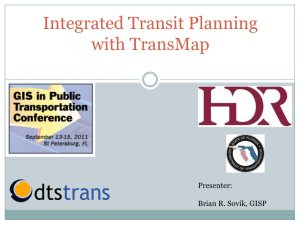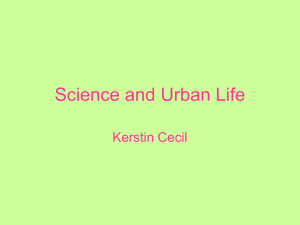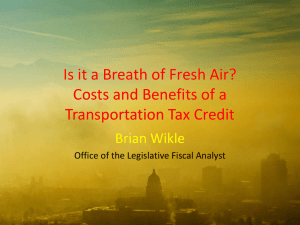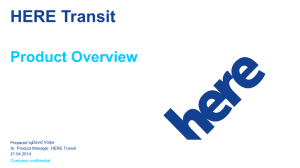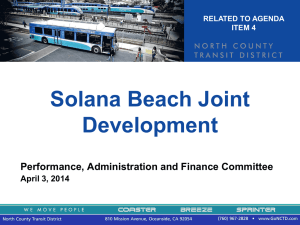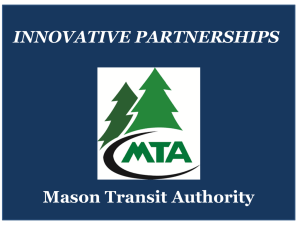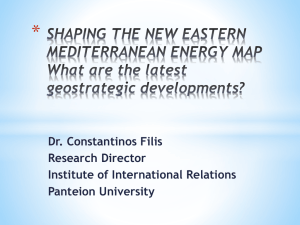TCRP H-37 Update: Characteristics of Premium Transit
advertisement
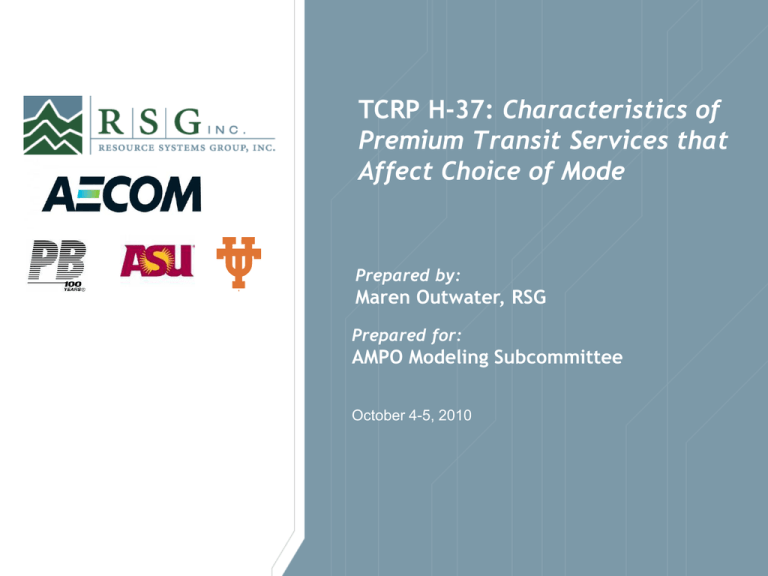
TCRP H-37: Characteristics of Premium Transit Services that Affect Choice of Mode Prepared by: Maren Outwater, RSG Prepared for: AMPO Modeling Subcommittee October 4-5, 2010 Overview 1.Literature Review 2.Surveys 3.Quantifying Premium Transit Attributes 4.Transit Familiarity and Awareness 5.Conclusions 6.Next Phase 2 Project Overview Purpose – To describe the most important factors that differentiate premium transit services from standard transit services – To provide methods to measure the impact of these distinguishing features – To propose ways to incorporate these measurements into regional planning activities Approach – To quantify non-traditional transit attributes that affect mode choice – To evaluate transit familiarity and awareness Phase 1 (complete) – Data collection for one city – Salt Lake City – Research and analysis of non-traditional transit attributes in mode choice models and awareness of transit services – Recommendations to bring these analyses into practice Phase 2 (underway) – Data collection for two cities – Chicago and Charlotte – Additional analyses of attributes and awareness, including choice set and mode choice models – Demonstration of the models in practice in one city (TBD) 3 Literature Review: Non-traditional Attributes Reliability: right of way, signal priority Convenience: type of transfers, span of service Comfort: at station or stop, cleanliness, shelter and seating; on-board, layout and seating, Crowding: seat capacity, seat availability, standing, crush loads Accessibility: walkability, ease of boarding, parking availability Information services: route information, announcements, real time arrival information Fare payment: POP, payment ease, speed of boarding Safety: Cameras, day/night security, lighting, visibility All of these attributes were included in mode choice model estimation and quantified except fare payment 4 Salt Lake Survey RSG’s Geocoding Module Part 1: Background Part 2: Transit Awareness and Consideration Part 3: Trip (Revealed Preference) Part 4: Trip (Stated Preference) Part 5: Transit User Preferences Total Respondents: 2,017 5 Quantifying Premium Transit Attributes Nested logit choice models for work and non-work purposes Generally reasonable coefficients for traditional attributes – Signs & magnitudes & relative ratios – No coefficients were asserted Attribute Mode Utility Eqn. Coefficient Std. Err t-stat Value IVTT (min) All modes -0.034 0.005 -7.109 Access time (min) Bus,train -0.051 0.008 -6.379 1.491 times IVTT Wait time (min) Bus,train -0.048 0.004 -12.178 1.413 times IVTT Trip Gas Cost ($) Auto -0.240 0.024 -9.946 8.518 $ per hour Fare ($ one-way) Bus,train -0.346 0.015 -22.607 5.906 $ per hour Parking Cost ($/day) Auto -0.231 0.007 -32.744 8.823 $ per hour Transfers (0 = no, 1 = yes) Bus,train -0.340 0.040 -8.590 10.002 minutes Coefficients for non-traditional attributes seem plausible – Effects were logical and statistically significant – Interaction terms help phase in effects over length of trip 6 Key Findings for Attributes 20.0 18.0 16.0 On-board Amenities Cleanliness of Transit Vehicle On-Board Temperature 14.0 On-Board Seating Comfort On-Board Seating Availability 12.0 WiFi * Station Amenities 10.0 Station/Stop Security Station/Stop Benches Cleanliness of Station/Stop 8.0 Proximity to Services Station/Stop Shelter 6.0 Station/Stop Lighting/Safety Transit Info 4.0 Reliability 2.0 Work Trips Non-Work Trips 7 Key Findings for Attitudes The convenience/inclination factor – currently make an effort to take transit, – think the transit system is easy to purchase a fare, and – know when the next bus or train will arrive. The service availability factor – could use transit more frequently – are able to take transit from home to downtown Salt Lake City – are able to take transit to useful destinations 20.0 18.0 Bus users inclination factor (Train Only) 16.0 Transit users service availability factor 14.0 Transit users inclination factor 12.0 10.0 8.0 6.0 4.0 2.0 Work Trips Non-Work Trips 8 Interaction between IVTT and on-board amenities The longer the trip, the more important premium on-board amenities become: – At 30 minutes, premium on-board amenities are worth 7.5 minutes of travel time – At 60 minutes, premium on-board amenities are worth 12 minutes of travel time Difference in IVTT with Premium OnBoard Amenities (work) 70 60 50 40 30 20 10 0 -10 0 15 With Premium On-Board Amenities 30 45 60 Without Premium On-Board Amenities 9 Interaction between Wait and Real-Time Info The longer the wait, the more important real-time information becomes: – At 10 minutes of wait time, real-time information are worth 5 minutes of travel time – At 20 minutes of wait time, real-time information are worth 6.5 minutes of travel time Difference in WAIT with Real-Time Information (work) 25 20 15 10 5 0 -5 0 5 With Premium Off-Board Amenities 10 15 20 Without Premium Off-Board Amenities 10 Familiarity with the Transit System Travelers are most familiar with Light Rail 11 Awareness of Transit near Home Travelers are most aware of transit within walking distance from home 12 Key Findings for Awareness & Consideration Traveler awareness of transit is – Stronger for transit within walking distance – Limited in terms of full range of transit sub-mode options – Less for opportunities to drive to transit – Higher for travelers dependent on transit Reported availability of modal alternatives is – Lower than modeled (typically limited to 0 or 1 alternatives) – Lower for users who perceive dependence on current mode Traveler perceptions of travel times are – Higher for local bus users than rail or express bus users Traveler consideration of transit is – A limiting factor for riding transit beyond awareness – Affected by mode (reasons for not riding vary by mode) All of these findings will be confirmed by more targeted survey research 13 Awareness of Specific Choices for a Trip Travelers report fewer modes being available than the modeled representations of choice availability for a particular trip. 70% 60% 50% 40% 30% 20% 10% 0% 0 1 2 3 Perceived Auto Perceived Bus Perceived Rail Actual Auto Actual Bus Actual Rail 14 Key Findings from Phase 1 Non-traditional attributes are significant in mode choice – Reliability – Real-time transit information – Stop/station amenities – On-board amenities – The option to work from home Travelers have an uneven and incomplete awareness of transit – Spectrum of choices – Constraints on modal options – Stops or stations near home and park-and-ride lots short drive away – Inaccurate/different representation of travel time Traveler attitudes also affect mode choice – Inclination to use transit – Attitudes about service These are the additional characteristics that affect choice of mode. 15 Bringing Results into Practice Incorporation of non-traditional transit attributes – Methods to develop these data in the base year – Methods to forecast non-traditional transit attributes Choice set availability – Traveler’s awareness of modal options – Traveler’s constraints on modal options – Traveler’s consideration of modes Representation of travel times – Assumptions used in path building don’t match traveler’s perception – Conduct further analysis of travel time components There is more work needed to quantify the impact of the individual characteristics for transit planning purposes. 16 Phase 2 Evaluation of Premium Transit Services Collect survey data in Chicago and Charlotte Develop choice set models to measure impact of awareness and consideration Update transit path building and network assumptions to match perception of travel times Include non-traditional attributes in mode choice models – reliability – real-time transit information – stop/station amenities (security, benches, cleanliness, proximity to services, shelter, lighting/safety) – on-board amenities (cleanliness, temperature, seating comfort, seating availability, and WiFi) – traveler attitudes – fare payment (new) 17 Questions? Contact Maren Outwater Resource Systems Group moutwater@rsginc.com 425-269-9684 18
